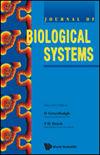SPATIOTEMPORAL DYNAMICAL ANALYSIS OF A PREDATOR–PREY SYSTEM WITH FEAR AND GROUP DEFENSE IN PREY
IF 1.5
4区 数学
Q3 BIOLOGY
引用次数: 4
Abstract
This paper considers a diffusive prey–predator system with fear and group defense in the prey population. Also, we consider that the mortality of predators is linear and quadratic. By using local stability analysis, we get the prerequisite of Turing instability. Using comprehensive numerical computations, we get non-Turing pattern formation in the system with linear death of predator. Turing patterns are obtained for the system with the quadratic death of the predator. The modeling technique of multiple scale analysis is used to determine amplitude equations near the Turing bifurcation origin for the model with the predator’s quadratic mortality rate. The amplitude equations stability leads to various Turing patterns such as spots, stripes, and mixed. The result focuses on changing the mortality rate linear to quadratic of a predator in the prey–predator system. The derived results support us in a more immeasurable understanding of prey–predator interaction dynamics in the actual world.具有恐惧和群体防御的捕食者-被捕食系统的时空动力学分析
本文考虑了一个具有群体防御和恐惧的扩散捕食系统。此外,我们认为捕食者的死亡率是线性和二次型的。通过局部稳定性分析,我们得到了图灵不稳定性的前提条件。通过综合数值计算,我们得到了捕食者线性死亡系统中的非图灵模式形成。得到了捕食者二次死亡系统的图灵模式。对于捕食者二次死亡率模型,使用多尺度分析的建模技术来确定图灵分岔原点附近的振幅方程。振幅方程的稳定性导致了各种图灵模式,如斑点、条纹和混合。研究结果集中于将捕食者的死亡率从线性变为二次型。所得结果支持我们对现实世界中猎物-捕食者相互作用的动力学有更不可估量的理解。
本文章由计算机程序翻译,如有差异,请以英文原文为准。
求助全文
约1分钟内获得全文
求助全文
来源期刊
CiteScore
2.80
自引率
12.50%
发文量
31
审稿时长
1 months
期刊介绍:
The Journal of Biological Systems is published quarterly. The goal of the Journal is to promote interdisciplinary approaches in Biology and in Medicine, and the study of biological situations with a variety of tools, including mathematical and general systems methods. The Journal solicits original research papers and survey articles in areas that include (but are not limited to):
Complex systems studies; isomorphies; nonlinear dynamics; entropy; mathematical tools and systems theories with applications in Biology and Medicine.
Interdisciplinary approaches in Biology and Medicine; transfer of methods from one discipline to another; integration of biological levels, from atomic to molecular, macromolecular, cellular, and organic levels; animal biology; plant biology.
Environmental studies; relationships between individuals, populations, communities and ecosystems; bioeconomics, management of renewable resources; hierarchy theory; integration of spatial and time scales.
Evolutionary biology; co-evolutions; genetics and evolution; branching processes and phyllotaxis.
Medical systems; physiology; cardiac modeling; computer models in Medicine; cancer research; epidemiology.
Numerical simulations and computations; numerical study and analysis of biological data.
Epistemology; history of science.
The journal will also publish book reviews.

 求助内容:
求助内容: 应助结果提醒方式:
应助结果提醒方式:


